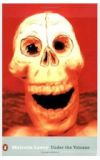
03 Nov 2011 10:30:56
Today is All Souls' Day, the culmination of Mexico's Day of the Dead and the date on which, in 1938, the events of Malcolm Lowry's Under the Volcano take place. I came to the book knowing only its reputation as a masterpiece of English modernism. I left thinking it one of the greatest novels of the 20th century. Everyone should read it at least twice – Lowry thought several readings were necessary for its full meaning to "explode in the mind" – and 2 November should see Cuernavaca (to which Lowry restores its Nahuatl name of Quauhnahuac) overrun with men and women posing as disgraced members of the diplomatic corps, a Latin Bloomsday for mescal freaks.Well, perhaps not that. Better that more people just read the thing. An atmosphere of difficulty cloaks the book like the thunderheads that hide the "immense flanks" of Popocatepetl, one of the two volcanoes in whose shadows the doomed alcoholic consul, Geoffrey Firmin, his estranged wife Yvonne, and his half-brother Hugh confront their fates. First published in 1947, Volcano had the troubled early life typical of unique books. It sold well in the United States, but in Britain it was remaindered and in Canada, where it was written (Canadians are proprietary towards Lowry, who spent the happiest period of his life there), it sold only two copies between the end of 1947 and 1949. Its reputation grew over the years following Lowry's death in 1957, but it remains a book that deeply divides opinion. Not because of the book's "what", which is fairly straightforward, but its "how": tangled time schemes and a Faulknerian stream of consciousness are just two of the prominent challenges with which Lowry tests readers.
Another potential obstacle is an extremely dense and allusive prose style, which people find either intoxicating or infuriating. Lowry, with significant editorial help from his second wife, Margerie, spent almost 10 years writing and revising Volcano, the book not really changing in length but becoming an ever thicker "forest of symbols" (this phrase from Baudelaire was of signal importance to Lowry, who had the Consul quote it in an earlier draft of the novel). Lowry was a student in the 1920s, and the allusiveness of Volcano is clearly a response to The Waste Land and Ulysses; it incorporates Greek myth, the Cabbala, Shakespeare, Shelley, Coleridge, Blake, the Mahabharata, Marvell, Paracelsus, and much besides. Above them all, asserting the book's explicitly Faustian aspect, stand Goethe, Marlowe, and Dante. "Lowry," as his biographer Douglas Day notes drily, "had no gift for simplicity".
In many ways Lowry is closer to Melville and Conrad than Joyce, but he creates his corner of Mexico in a manner similar to the Dublin of Ulysses: not by describing it so much as by building an alternate reality from language. The complexity of the book's construction is staggering, as proven by the 31-page letter Lowry wrote to Jonathan Cape in 1946 in response to a critical reader's report, which gives a detailed explanation of the logic underpinning the book's intense vision. Similarly, in a 1951 letter to his German translator Lowry describes the character Weber, an American gunrunner, as "not very important, in one way, and yet he has to be there, bracing something far down within the substructure of the whole". He then explains, over four crammed pages, just how Weber fits in to what Michael Schmidt calls Volcano's "root system of symbolic connections and counter-references".
Lowry's schematic command of his novel does not mean he was always in command at the level of the sentence. A common complaint is that Volcano is overwritten, and in places that's undoubtedly true. "Hugh put one foot up on the parapet and regarded his cigarette that seemed bent, like humanity, on consuming itself as quickly as possible," is one of several lines likely to produce the wrong sort of gasp. But occasional slips like this are, I believe, an almost unavoidable by-product of such fervid writing, and are anomalies amid writing of arresting power and beauty. In a letter of 1950 Lowry said of the writing process that "after a while it began to make a noise like music, when it made the wrong noise I altered it – when it seemed to make the right one, finally, I kept it". This approach results in a book that, as the journalist DT Max has noted, "risks everything at every moment".
Fervour is intrinsic to the way in which the book moves back and forth across the border separating the world and the consul's increasingly deranged apprehension of it. Throughout, a series of motifs generate a growing significance: film posters for the horror film, "Las Manos de Orlac, con Peter Lorre"; the phrase "a corpse will be transported by express"; the numbers seven, 12 and 666; a misread sign asking "¿Le gusta esta jardín?" and a dying Indian on the road; the barrancas that flank Quauhnahuac; the "hideous" pariah dogs that track the consul's steps; the graffito "No se puede vivir sin amar" ("One cannot live without love"). Each of these, examples of what William Gass calls the "wormy ubiquitousness of the sign" that riddles Volcano, are layers demanding exegesis.

